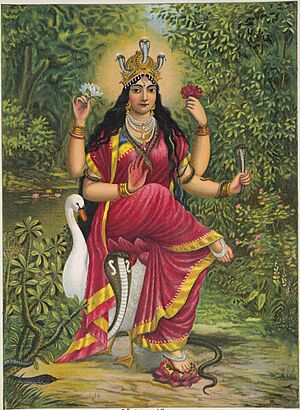Manasa facts for kids
Quick facts for kids Manasa |
|
|---|---|
| Goddess of snakes and poison | |
 |
|
| Bengali / Hajong | মনসা / কাণি দেউও (Kānī Dīyāʊ) |
| Affiliation | Devi, Nāga, daughter of Lord Shiva |
| Abode | Naga loka |
| Mount | Snake, Swan |
| Personal information | |
| Consort | Jaratkaru (Jagatkaru) |
| Children | Asthika |
| Parents | Shiva and Parvati (real parents) Kashyapa and Kadru (foster parents) |
Manasa (Bengali: মনসা, Manasha), also known as Manasa Devi, is a Hindu goddess. She is known as the goddess of snakes and poison. People mainly worship her to stay safe from snakebites and to get well from illnesses like smallpox. She is also prayed to for good luck and having children.
Manasa is also called Vishahara, which means "the destroyer of poison." Other names for her include Jagadgaurī, Nityā (meaning "eternal"), and Padmavati. She represents both ending things and new beginnings, like a snake shedding its skin to grow.
Contents
Who is Manasa?
Manasa started as a goddess for tribal groups. Over time, she became part of the wider Hindu group of gods and goddesses. First, people from lower castes accepted her. Later, people from higher castes also began to worship her. Today, she is seen as a major Hindu goddess.
How Manasa Looks
Manasa is often shown as a beautiful lady. Her body is decorated with snakes. She usually sits on a lotus flower or stands on a snake. Above her head, there is a canopy made of seven cobra hoods. A goose is often seen next to her.
Sometimes, she is shown as "the one-eyed goddess." In some pictures, her son Astika is on her lap. One story says her stepmother, Chandi, burned out one of her eyes because of jealousy.
Stories and Legends
Many stories about Manasa talk about her strong temper. They also mention her sadness. This is because some beliefs say her father, Shiva, did not accept her. Also, her stepmother, Chandi, disliked her. In other stories, Sage Kashyapa is believed to be her father. Her legends tell us about her life and adventures.
Manasa's Marriage in the Mahabharata
The ancient Hindu epic, the Mahabharata, tells the story of Manasa's marriage. A wise man named Jagatkāru had decided not to marry. One day, he saw a group of men hanging upside down from a tree. These men were his ancestors. They were stuck in this state because their children had not performed important rituals after their deaths.
So, they asked Jagatkāru to marry and have a son. This son could then perform the rituals to free them. A powerful serpent king named Vasuki offered his sister, Manasa, to Jagatkāru. Even though Jagatkāru had planned to stay unmarried, he agreed. Manasa and Jagatkāru had a son named Astīka. Astīka performed the necessary rituals and freed his ancestors. Astīka also helped save the Nāgas (snake beings) from a great fire ritual.
Manasa's Birth in the Puranas
The Puranas are another set of Hindu scriptures. They tell a different story about Manasa's birth. In these stories, Sage Kashyapa is her father, not Shiva. The Puranas say that snakes and reptiles were causing a lot of trouble on Earth. To fix this, Sage Kashyapa created Manasa from his mind (mana).
The creator god, Brahma, then made Manasa the goddess of snakes and poison. Manasa gained control over the Earth by chanting special prayers called mantras. She then pleased the god Shiva. Shiva told her to please the god Krishna. Because Krishna was pleased, he gave her special divine powers. He also made her an official goddess by ritually worshipping her.
How Manasa is Worshipped
Manasa is often worshipped without an idol of an animal. Instead, people might use an earthen pot, a tree branch, or a clay snake image. Sometimes, statues of Manasa are also worshipped. She is prayed to for protection from snakebites and for healing from poison.
Manasa is mostly worshipped in the Bengal region of India. She is also worshipped during festivals like Nag Panchami, which is a snake festival. In Assam, a musical folk theater is dedicated to her stories. Manasa is mainly worshipped during the rainy season. This is when snakes are most active.
Images for kids
-
Manasa with her husband Jaratkaru & son Astika flanked by Nagas, 11th century Pala period statue from Bengal
-
Mud idol of Manasa in the Sundarbans, West Bengal, India.
-
Manasa puja on the day of Dashahara at a bedi of Euphorbia neriifolia, in West Bengal.
-
Women with the Manasa Sila (murti) during puja at Birbhum in 2021
-
Mata Mansa Devi Mandir, Panchkula, near Chandigarh.
See also
 In Spanish: Manasá (diosa hinduista) para niños
In Spanish: Manasá (diosa hinduista) para niños










